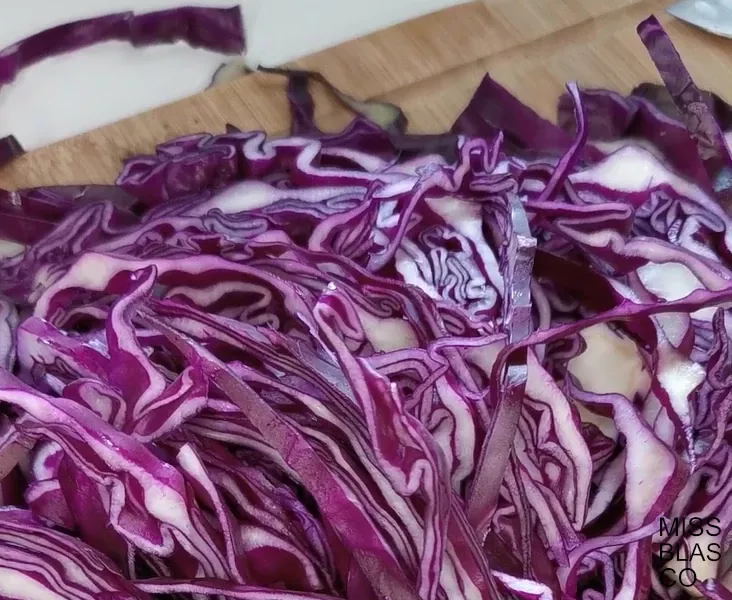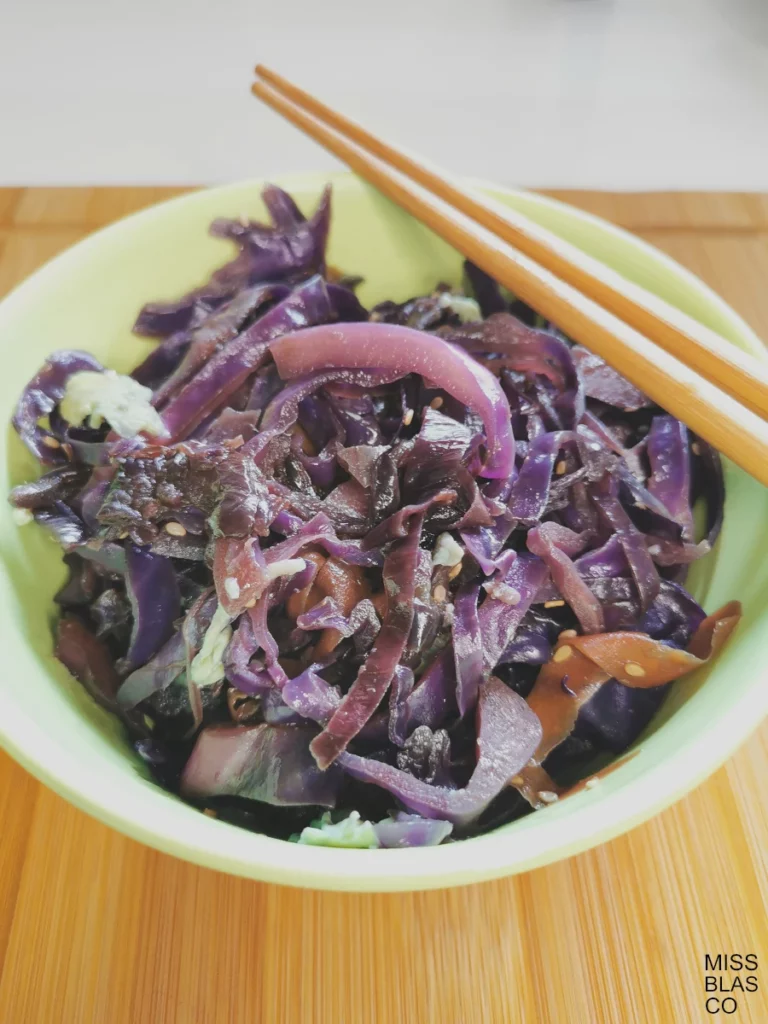
Easy Red Cabbage Stir Fry
Red Cabbage Stir-Fry: A Simple Way to Add Polyphenols to Your Diet
Red cabbage is one of the most versatile and nutrient-dense vegetables you can add to your meals. Belonging to the cruciferous family, it offers an impressive nutritional profile that makes it an excellent ally for health, especially during the colder months when hearty, colorful dishes feel most comforting. One delicious way to enjoy it is this Easy Red Cabbage Stir Fry, a simple recipe that combines vibrant flavor with powerful health benefits.
This dish is more than just a side; it is a perfect example of how everyday meals can provide compounds that help protect long-term health. Among its greatest advantages, red cabbage is particularly rich in polyphenols—plant-based compounds with proven anti-inflammatory and antioxidant effects. In addition, it provides vitamin C, fiber, and prebiotic properties that support gut health.
Why Purple Foods Are So Beneficial
Purple and red-colored foods are naturally rich in polyphenols. These compounds play a unique role in human health because most of them (around 90–95%) are not absorbed in the small intestine. Instead, they reach the colon, where they serve as food for beneficial gut bacteria.
In the colon, bacteria break down these long-chain compounds into smaller, bioactive molecules with strong anti-inflammatory and anticarcinogenic effects. This process also stimulates the production of short-chain fatty acids (SCFAs) such as butyrate, acetate, and propionate, which are essential for gut health, immune balance, and metabolic regulation.
Examples of polyphenol-rich foods include:
- Red cabbage
- Blueberries, blackberries, and other red or purple berries
- Red onion
- Grapes and cherries
- Green and black tea
- Dark chocolate and cocoa
- Nuts and seeds
Even red wine contains polyphenols, though it is not recommended as a primary source due to the presence of alcohol. The key takeaway is that color often indicates the presence of these beneficial compounds, and incorporating a wide variety of colorful foods can make a noticeable difference in health outcomes.
Purple vegetables like red cabbage are rich in polyphenols that protect against inflammation and oxidative stress.

What Are Polyphenols?
Polyphenols are natural compounds found in a wide variety of plant-based foods, including fruits, vegetables, grains, legumes, tea, and cocoa. Their chemical structure is characterized by multiple phenolic rings, which give them the ability to neutralize free radicals and reduce oxidative stress.
Different groups of polyphenols include:
- Flavonoids – abundant in fruits, vegetables, tea, and dark chocolate.
- Hydroxycinnamic acids – present in coffee, cereals, and fruits.
- Stilbenes – found in grapes and nuts.
- Proanthocyanidins – present in apples, grapes, and some nuts.
Polyphenols are linked to multiple health benefits:
- Supporting cardiovascular health
- Reducing blood glucose levels
- Lowering the risk of type 2 diabetes and metabolic syndrome
- Protecting cognitive function and brain health
- Strengthening the immune system
- Reducing the risk of certain cancers
Incorporating foods high in polyphenols into your diet is therefore an essential step toward long-term well-being.
Benefits of Polyphenols at a Glance
- They support the diversity and balance of the gut microbiota.
- They promote the production of SCFAs, improving intestinal health.
- They reduce oxidative stress and inflammation.
- They may help regulate blood sugar levels.
- They contribute to brain health and cognitive performance.
- They reduce the risk of cardiovascular disease.
For these reasons, including polyphenol-rich foods like red cabbage in simple meals such as a stir-fry can have a meaningful impact on overall health.
Variety is essential in the diet to ensure a complete supply of nutrients and avoid deficiencies.
The Importance of Variety in the Diet
While red cabbage is a valuable source of polyphenols, it should not be the only one. A key aspect of healthy eating is variety. Each food provides a unique combination of nutrients, and no single food can supply everything the body needs.
A varied diet ensures that we obtain adequate amounts of vitamins, minerals, fiber, and bioactive compounds. It also helps prevent nutrient deficiencies, supports weight management, and lowers the risk of chronic diseases such as obesity, type 2 diabetes, cardiovascular conditions, and certain cancers.
Another benefit of variety is that it makes meals more enjoyable. Rotating seasonal produce and trying new ingredients not only enhances nutrition but also prevents monotony at the table. Choosing different colors, textures, and flavors is an easy way to improve diet quality.
Recipe: Oriental-Style Red Cabbage Stir-Fry
This recipe is a practical way to include red cabbage and other polyphenol-rich ingredients in your meals. It is quick to prepare, flavorful, and deeply nourishing.
Ingredients (serves 4):
- 500 g red cabbage (about ½ medium head)
- 100 g red onion (2 small onions)
- 1 garlic clove
- 100 g carrot (2 medium), cut into strips
- 1 tbsp extra virgin olive oil
- 2 tbsp low-sodium soy sauce
- 4 eggs
- 1 pinch black pepper
- 1 pinch sea salt
- 1 tbsp toasted sesame seeds
Preparation:
- Slice the red cabbage and onion into thin strips. Peel and press the garlic clove.
- Heat the olive oil in a large pan and gently sauté the garlic until fragrant, being careful not to burn it.
- Add the onion and cook until softened. Season lightly with salt, keeping in mind that soy sauce will be added later.
- Incorporate the red cabbage, stirring well. Add a pinch of black pepper, cover, and cook for about 15 minutes until tender.
- Stir in the soy sauce and mix thoroughly.
- Meanwhile, peel and slice the carrots into thin strips and add them to the stir-fry. Cook for another 5 minutes.
- In a separate pan, scramble the eggs until just set, then fold them into the cabbage mixture.
- Sprinkle with toasted sesame seeds before serving.
The result is a vibrant, colorful dish that can be enjoyed as a side or light main course.
Stir-fried red cabbage is a simple, tasty way to increase polyphenol intake in everyday meals.
Would you like to watch the video recipe?
Explore more healthy low-carb recipes: